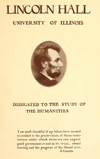Lincoln Hall Project
Subscribe
Past Events
The 1913 Dedication of Lincoln Hall
Lincoln Hall’s dedication in 1913—and rededication in 2013—were both celebrated on Abraham Lincoln’s birthday on February 12, exactly 100 years apart. The programs below show how the University of Illinois honored Lincoln Hall a century ago.
In Preparation of the Dedication
Although Lincoln Hall opened in 1911, the dedication didn't occur until 1913 primarily because the American Terra Cotta Company didn’t complete the scenic panels for the building until August 1912, as John Hoffman explains in his book Lincoln Hall at the University of Illinois. The dedication of Lincoln Hall was such an important ceremony that President Edmund J. James had canceled classes so students and faculty could attend the proceedings, according to Hoffman.
President James even invited Abraham Lincoln's son, Robert Todd Lincoln, who was 69 at the time, to attend the dedication; however, he declined. Hoffman writes: “Expressing his ‘gratification at such a monument being erected to the memory’ of his father, the son carefully explained that he was not well, and accordingly was...avoiding ‘any large assemblages, even operatic and theaterical performances.’”
1913 Dedication Program
 It was described as “a laboratory for the intellectual sciences.” A place where, “until 10:00 at night, students and professors [were] working at the same tables, using the same materials, drawing guidance, inspiration, and interest from one another.” In Lincoln Hall, “no teacher trained in these surroundings [could] fail to get a touch of real inspiration, which [would] in turn react upon his pupils, and thus...reach...the people of the state.” These details and more were described in the original dedication program for Lincoln Hall in 1913. View a PDF of the dedication program.
It was described as “a laboratory for the intellectual sciences.” A place where, “until 10:00 at night, students and professors [were] working at the same tables, using the same materials, drawing guidance, inspiration, and interest from one another.” In Lincoln Hall, “no teacher trained in these surroundings [could] fail to get a touch of real inspiration, which [would] in turn react upon his pupils, and thus...reach...the people of the state.” These details and more were described in the original dedication program for Lincoln Hall in 1913. View a PDF of the dedication program.
1913 Dedication Speakers

We know many details of the original Lincoln Hall dedication on February 12, 1913, thanks in large part to an 1884 U of I graduate named Alma Elizabeth Braucher. She apparently attended the dedication and was impressed enough that she donated a copy of the speaker program that remains on file at the University Archives. Braucher was an active and driven woman, born in rural Logan County in 1858 before earning her bachelor's degree in science in Urbana-Champaign. In 1895, she earned her medical degree from Hering Medical College in Chicago. In light of what she's left behind, it's a fitting coincidence that her birthplace was just a couple miles outside of Lincoln, Ill. She attended Lincoln High School, and after college she lived at 227 Lincoln Ave., in Lincoln. She died in Lincoln on October 30, 1928.
The speaker program is transcribed below:
Morning Program
Morrow Hall
9-12 O’Clock
The Importance to the Commonwealth of Adequate Provision for the Study of the Humanities
ADDRESS
The Philosophical Studies
Frederick J. E. Woodbridge, LL.D.,
Professor of Philosophy in Columbia University
ADDRESS
Language and Literature
Bliss Perry, L.H.D., Litt.D., LL.D.,
Professor of English Literature in Harvard University
ADDRESS
The Social Sciences
Albert Shaw, Ph.D., LL.D.,
Editor of the American Monthly Review of Reviews
Luncheon in Woman’s Gymnasium at Twelve-thirty o’clock
Afternoon Program
The Auditorium
Three O’Clock
SCRIPTURE READING AND PRAYER
The Reverend Doctor William F. McDowell,
Bishop of the Methodist Episcopal Church
MEMORIAL ADDRESS
Abraham Lincoln
The Reverend Hugh Black, D.D., LL.D. of Union Theological Seminary
ADDRESS
W. Carbys Zimmerman,
The State Architect
ADDRESS
Transferring the Building to the Trustees
His Excellency, Edward F. Dunne, LL.D.,
The Governor of the State
RESPONSE AND ADDRESS
Committing the Building to the Immediate Care of the President of the University
William L. Abbott, M.E.,
President of the Board of Trustees
Adjournment to Lincoln Hall
PRAYER OF DEDICATION
Bishop McDowell
(Speaker program courtesy of the UI Histories Project.)
